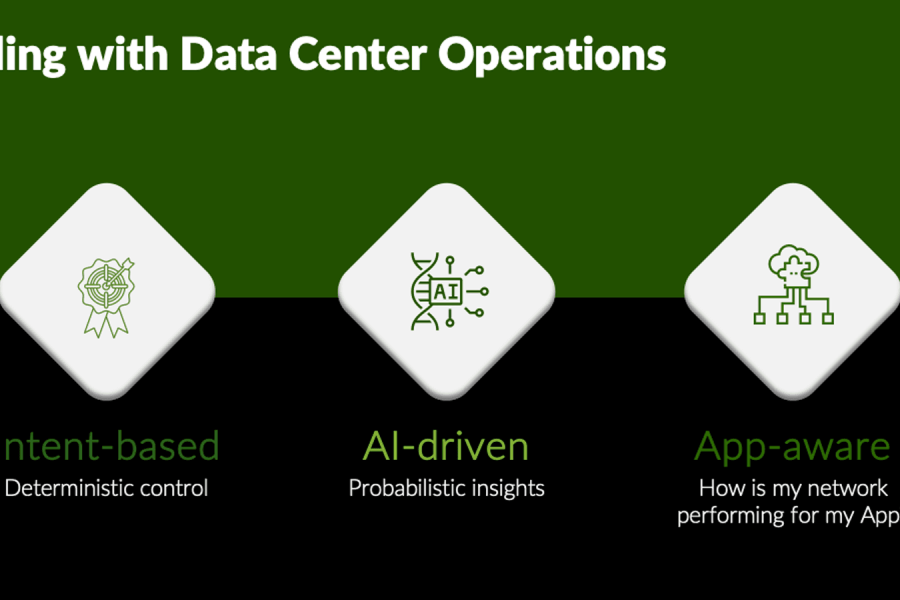This blog was originally published to the Apstra website – in 2021, Juniper Networks acquired Apstra. Learn more about the acquisition here.
The $48B spend on network operations
For every $1 spent on network equipment, up to $3 are spent on operating this equipment over its lifetime. Considering that enterprises are expected to spend $16B on data center Ethernet switches in 2019, the network operations spend is therefore a whopping $48B.
These numbers are striking, and quite surprising when you consider that most of the discussion around networking pertains to CapEx costs, and businesses often spend more time negotiating lower equipment acquisition costs from vendors than tackling the elephant in the room: optimizing the value obtained from their investment in operating costs.
The reason CIOs pay such high costs for network operations is simple: the network is the foundation of a business — the network holds up a business the same way a concrete foundation holds up a house. Essentially, the cost of not spending these $3 would be a lot higher.
Wasted costs from manual operations
But consider this: ONUG’s own research shows that engineers spend 80% of their time on CLI-driven, keyboard instantiated manual operations! This translates to $40B that can be massively optimized. Here are some examples:
- Lead times to design network architectures that meet the needs of the business. Most of that process is manual. Often, dozens of network engineers spend many months coming up with such designs.
- The resources required to build a new instance of a given network design manually – including the time required to put together configurations for every device, test the configurations in a working system, and run all the tests to validate configurations for all the components.
- The amount of time needed to debug outages — both the root cause of the outage, and its blast radius. In many cases, network engineers are forced to log into various suspected devices manually looking for clues.
- Interesting projects that get started, then get dropped because of lack of time, i.e. projects that would investigate approaches to transition from their current infrastructures to cloud infrastructures.
Wasted opportunity costs from manual operations
Now let’s consider this: how much business value would be unleashed if engineers spent less time on manual operations?
And it gets much worse.
Consider how much business value would be unleashed if engineers were to stand up new PODs in a day instead of 6 months.
And, the real cost of manual operations can be much higher in a dynamic business because of lost revenue opportunities resulting from the lack of agility. Instead of spending 80% of their time on manual operations, network engineers could dynamically provision resources for those business services, hence unlocking the associated revenues.
Also, outages are extremely expensive to the business, and very hard to debug. Network components have transient failures all the time, and they often result in “grey” failures that are exceedingly difficult to root-cause. Instead of spending 80% of their time on manual operations, imagine if network engineers spent this time deploying more effective tools to help them debug those outages, or — even better — prevent outages in the first place.
Essentially, carbon-based automation — the ever-present ‘throw more swivel chairs at the problem’ costs time, increases error rate, increases the risk of outages, results in longer deployment cycles, vendor lock-in, and general inefficiency. And it is a waste of a business’ most valuable resource: their experienced network engineers.
Defining the manual tax
In order to tackle this notion, we define the “manual tax” as the aggregate opportunity cost businesses incur, i.e. the delta between the business value network engineers would deliver if they did not have to spend 80% of their time on manual operations, versus the value they deliver today.
Our analysis shows that in many cases, the manual tax rate can exceed 80%! Including the manual tax, the effective operational cost for every $1 spent on network equipment could be massively larger — easily $7, and in some cases a lot more!
Unleashing $100B+ of trapped value
Unleashing $7 of value for every $1 spent on network equipment translates to $100B+ of trapped value!
In summary, the current way of operating networks is very inefficient. At $3 for every $1 of capex, it’s very expensive. Yet this number pales in comparison to the opportunity cost that results from not operating them well! The opportunity costs associated with the loss of agility, as well as the costs of outages and brownouts that result from manual operations exceed the operational expenses themselves. And in a cloud world where business services are increasingly dependent on agile and reliable network services, the associated costs are significantly higher.
You can do something about it — today
With this high manual tax, the only solution is to automate all aspects of manual operations. Network automation capabilities that can significantly lower this manual tax rate are here today, and can enable businesses to increase the value obtained from their investment in operations tremendously.


